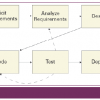 |
The Danger of Testing "Only" Stories Finding defects late is a common issue when teams don't consider levels of precision or detail. You must take into account how stories and features fit into the system. In this FAQ column, Janet Gregory tells you how you should remember the big picture—even while testing the small stuff.
|
|
 |
Quick, Before We Release Matt Heusser presents ten key factors to establish a team cadence—the time between running tests and getting a product into production. The shorter the cadence, the less time spent in test/fix/retest land, and the more time spent working on new features.
|
|
 |
You Can't Be Agile without Automated Unit Testing Agile projects assume that test planning, test creation, and test execution take place throughout a project's lifecycle. So the need for unit testing (and especially automated unit testing) can't be ignored and should be considered as a key responsibility of the entire team—not just the software developers.
|
|
|
|
Simplicity and Precision: Test Planning in Agile Projects Test planning is often thought unnecessary in an agile project. However, if our mindset is on "planning" rather than "plans," we see that test-planning activities happen throughout the project, taking advantage of levels of precision, i.e., what is absolutely necessary at each level.
|
|
 |
How Do You Write Good User Stories? Expert answers to frequently asked questions. In this issue, David Hussman explains how to write good user stories.
|
|
 |
Increase Quality with Table-Driven Acceptance Tests Vague or ambiguous requirements can cause loops in development processes. Creating requirements that include acceptance tests cuts down on the looping and increases the flow of working software to the customer.
|
|
|
|
Constructing the Quality Story Knowledge doesn't just exist; we build it. Sometimes we disagree on what we've got, and sometimes we disagree on how to get it. Hard as it may be to imagine, the experimental approach itself was once controversial. What can we learn from the disputes of the past? How do we manage skepticism and trust and tell the testing story?
|
|
|
|
Food for Thought Ideas about testing can come from many different and unexpected sources, including reductionism, agronomy, cognitive psychology, mycology, and general systems. Michael feasts on Michael Pollan's "The Omnivore's Dilemma" and finds much to whet the tester's appetite for learning about how things work.
|
|
 |
Crash Course in Proficient Presenting Ben has to make a presentation at the next all-hands meeting. It'll be his very first presentation, and just thinking about it has sent him into a panic. Fortunately, he has the support of an experienced speaker and coach who offers advice and encouragement to help him become a proficient, panic-free presenter.
|
|
 |
GUT Instinct Whether or not a unit test is considered good is not simply about what it tests: It is also very much about "how" it tests. Is the test readable and maintainable? Does it define the expected behavior or merely assume it? To be sustainable, the style of a unit test is just as important as the style of any other code. Perhaps a little surprisingly, the most commonly favored test partitioning style does not meet these expectations.
|
|

